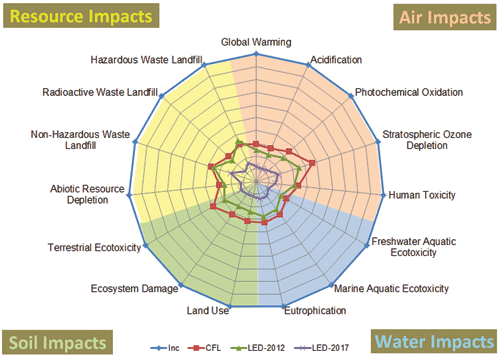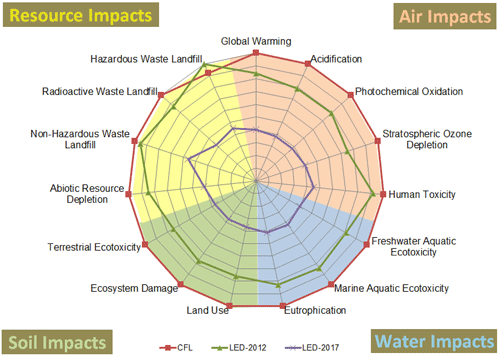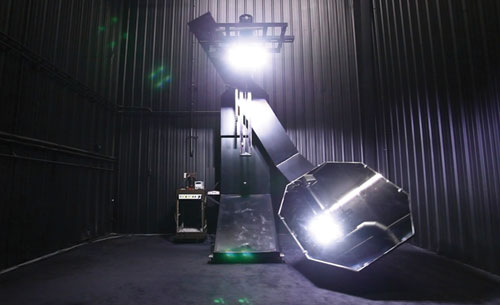Replacing the Fluorescent Lamp with Linear LED Luminaires
The study found that energy-in-use is the dominant negative environmental impact, and that LEDs and CFLs are similar in energy consumption. But by 2017, the prospective negative environmental impacts of the improved LED lamp will be significantly less than incandescent, about 70 percent lower than CFLs, and approximately 50 percent lower than current 2012 LED solutions. The spider web charts spell out 15 environmental impacts in four sectors.
 |
Life-cycle assessment impacts of the lamps analyzed relative to incandescent |
 |
Life-cycle assessment impacts of the lamps analyzed relative to CFLS Source: U.S. Department of Energy |
Testing Standards
The use of LEDs as a general light source has forced changes in test procedures used to measure lighting performance.
 |
Goniophotometer performing an LM-79 photometric distribution test Photo by IAEI |
Traditional photometry methods use a “relative photometry method,” where lighting energy efficiency was developed separately for lamp ratings and for fixture efficiency. A lamp rating indicates how much light (in lumens) the lamp will produce. A fixture efficiency, which is an appropriate measure for fixtures that have interchangeable lamps, indicates the proportion of rated lamp lumens actually emitted by the fixture.
In contrast, LEDs have a complex relationship between the LED light sources and the luminaire components, where manufacturers design LEDs as a unit. The performance of each unit is unique and is a function of the design and the manner in which the LEDs are integrated into the package or luminaire. LED luminaires, therefore, cannot be compared to other lighting systems, which separate lamp performance and fixture performance.
The efficiency of an omnidirectional fluorescent luminaire, for example, is measured according to relative photometry methods, i.e., lumens emitted by the lamp plus the performance of the fixture in directing “usable” light. Its efficiency is greatly limited by the fixture components (e.g., lenses, reflectors, or louvers), orientation of the lamp, and size of the fixture. But in the case of directional LED linear luminaires, where all the light is emitted in the intended direction, performance is improved because of less wasted light.
In order to evaluate LED products, the Illuminating Engineering Society of North America (IES) published LM-79-08, Approved Method for the Electrical and Photometric Measurements of Solid-State Lighting Products. LM-79 is a product testing method based on absolute photometry, which characterizes a luminaire as a whole and acknowledges its unique thermal, optical, and electrical properties (see sidebar “Test Method Quick Reference”). Its performance data provides a means for design professionals to evaluate different LED luminaires.
Of more interest to manufacturers, IES LM-80-08: IES, Approved Method for Measuring Lumen Maintenance of LED Light Sources, describes the measurement of lumen maintenance—the amount of light output maintained over time—for LED packages used in luminaries.
| Test Method Quick Reference |
IES LM-79-08: IES “Approved Method for the Electrical and Photometric Measurements of Solid-State Lighting Products.” Describes the method of absolute photometry for LED luminaires and integral replacement lamps, and associated electrical measurements. Provides performance data (i.e., light output and efficacy, light distribution, and color characteristics) for the entire, integrated product—versus separate results for the light source (“lamp”) and luminaire provided by traditional relative photometry. IES LM-80-08: IES “Approved Method for Measuring Lumen Maintenance of LED Light Sources.” Describes the measurement of lumen maintenance—the amount of light output maintained over time—for LED devices (i.e., single or multiple die chips). LED devices are operated for at least 6,000 hours at representative operating temperatures, with photometric data collected at a minimum of every 1,000 hours. Using modeling guidance from a proposed companion test method, IES TM-21 (see below), this “device-level” data can be applied to the integrated LED product to predict useful operating life and light output over time. IES TM-21: “Lumen Depreciation Lifetime Estimation Method for LED Light Sources” provides a method for determining an LED luminaire or integral replacement lamp’s expected operating life, based on initial LED performance data collected per IES LM-80 guidelines. IES TM-21was completed and released in 2012. Its testing/calculation method addresses the potential degradation paths seen with different LEDs and luminaire integration. Since TM-21 provides two values relating to L70 lifetime—reported hours and calculated hours—it is important for specifiers to understand how the two values are generated and the difference between them. ENERGY STAR provides an online TM-21 calculator for luminaire manufacturers to enter LM-80 data that consists of temperature measurements collected during in-situ heat testing and drive current used. Because of the time involved for LED manufacturers to create LM-80 data—most LEDs have only tested for 6,000 hours or 10,000 hours—TM-21 extrapolates the data from LM-80 (submitted by LED manufacturers) and provides a “reported” value and a “calculated” value for lumen depreciation and lifetime. For instance, a 6,000-hour LM-80 report can only result in a maximum “reported” 36,000-hour lumen depreciation estimate, while a 10,000-hour LM-80 report could only result in a maximum “reported” 60,000 hours lumen depreciation estimate. These reported values are very conservative and may be reporting lumen depreciation of 10 percent or less. The “calculated” values, on the other hand, are typically much higher, usually over 100,000 hours and are often cited in luminaire manufacturer data sheets. While LED luminaire products may very well perform to their calculated L70 lifetime, these calculated values should not be confused with reported values. IES LM-79 performance testing is typically conducted by independent testing labs on behalf of manufacturers or testing programs like DOE CALiPER.* Given its duration and space requirements, long-term testing under IES LM-80 is generally performed by LED device manufacturers. * More information on DOE’s Commercially Available LED Product Evaluation and Reporting (CALiPER) Program can be found at: www.ssl.energy.gov/caliper.html. |
Theoretical Limits of LED Technology
In regard to luminous efficacy (lumens produced per watts consumed), current proven performance in labs has delivered over 280 lm/W. Researchers have indicated a theoretical limit for white LEDs to be somewhere around 300 lm/W at the device level. LED devices with an efficacy of 300 lm/W will result in luminaires with the potential to deliver 240 lm/W or more, by far the most efficacious practical light source available for general lighting. This potential is certainly exciting and has developers of LEDs racing to reach this limit with major advances about every year.









